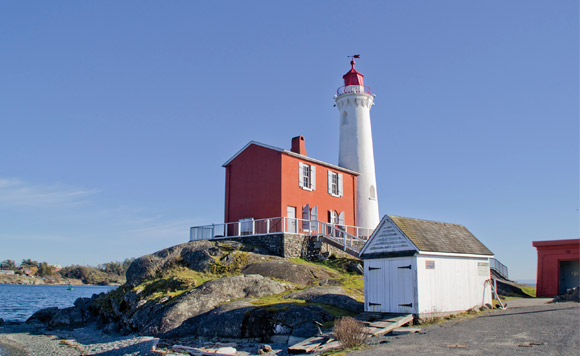by Jesse Holth –
One of the most remarkable features of Esquimalt Lagoon is how it almost feels below sea level. Part optical illusion and part reality (this low-lying area is considered a Tsunami Hazard Zone!), the wide expanse of ocean is visually striking. With parking all along the Coburg Peninsula, you’ll drive on the narrow spit of land that separates Esquimalt Lagoon from the rest of the ocean.
Take your pick: you can walk along the beach side, facing the Olympic mountains and a view of downtown Victoria, or you can walk along the lagoon side, where migratory birds come to rest. In fact, Esquimalt Lagoon is a Migratory Bird Sanctuary – birds often stop here on their journey between North and South America. The saltwater lagoon and surrounding trees are a birdwatcher’s paradise, where you can spot great blue herons, bald eagles, large groups of swans, and countless other species.
Don’t forget to bring the binoculars – they can help you spot wildlife, as well as iconic buildings like Hatley Castle, just inland of the lagoon. This area is also a great place to collect shells, and is popular with kayakers. It’s home to some of the oldest Douglas firs around Victoria – not to mention some of the biggest Douglas firs in the entire province. Just pay attention to the signage if you plan to bring your dog(s), as much of it is on-leash to protect this important bird habitat.
Esquimalt Lagoon has a very interesting history. About 10,000 years ago, toward the end of the Fraser Glaciation, a large chunk of ice separated from the rest of the ice sheet and began to melt. This eventually created the lagoon, while ocean currents deposited sediment around the ice block to create the Coburg Peninsula (where you now park your car). Used by First Nations for thousands of years, the lagoon provided opportunities for clam harvesting, fishing, and other subsistence activities. When the naval base was established at Esquimalt Harbour in 1854, they even used the Coburg Peninsula as a firing range. This continued until the late 20th century, when the military college was closed and Hatley Park became Royal Roads University.
Why not make a day of it? Head to nearby Fort Rodd Hill Historic Site, which includes the Fisgard Lighthouse – the first permanent lighthouse to be built on Canada’s west coast. Dating back to 1860, the interior has been turned into a two-storey exhibition about shipwrecks and the lighthouse’s history. Fort Rodd Hill itself is a coastal artillery fort that was built to protect Victoria and Esquimalt Naval Base in the 1890s. Plenty of command posts, guardhouses, gun batteries and underground magazines are still standing. Visitors can explore the grounds, tour some of the buildings, and walk a number of nature trails. Make sure to head down to the ocean, too – this beautiful lighthouse on the coastal bluffs is not to be missed.
Visit the Government of Canada websites for more information about the Migratory Bird Sanctuary and these important National Historic Sites.




